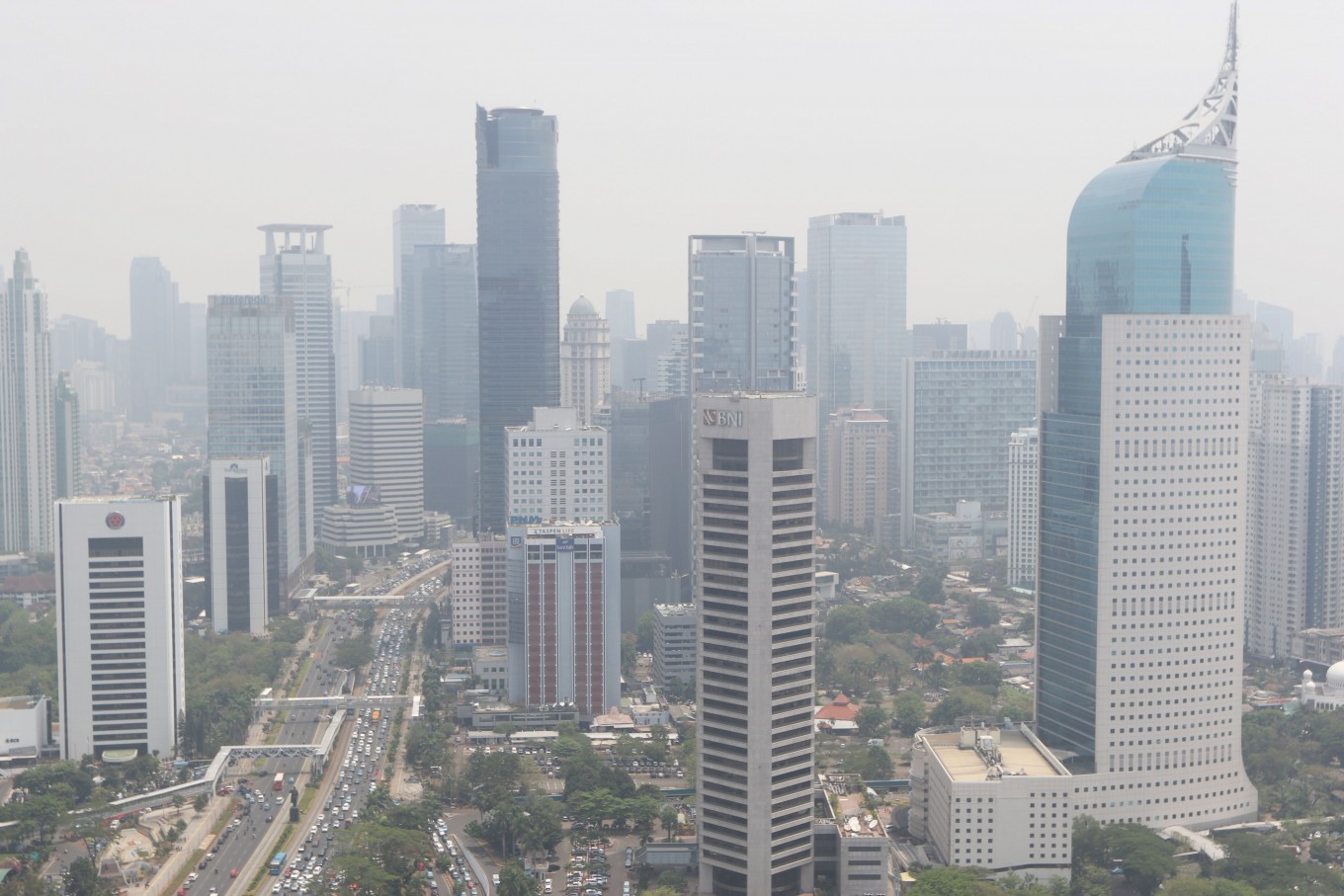Popular Reads
Top Results
Can't find what you're looking for?
View all search resultsPopular Reads
Top Results
Can't find what you're looking for?
View all search resultsNew partnership tackles Jakarta's air pollution
Change text size
Gift Premium Articles
to Anyone
W
ith traffic, coal-fired power plants and ongoing construction projects continuing to pollute Jakarta’s air, the city administration is seeking new solutions to improve air quality through a recently launched partnership.
Air quality experts from Bandung Institute of Technology (ITB) recently studied the concentration of PM2.5, fine particulate matter that have a diameter of less than 2.5 micrometers, in air samples taken from three locations across Jakarta – Gelora Bung Karno sports complex, Kebon Jeruk and Lubang Buaya. The study aimed to determine more accurately the sources of air pollution in Jakarta.
The study was conducted as part of a new partnership between the Jakarta administration, New York-based charitable foundation Bloomberg Philanthropies and global health organization Vital Strategies to enhance the availability and use of air quality data, formulate policies and educate the public about the health impacts of air pollution.
The research was conducted during the wet season from October 2018 to March 2019 and the dry season from July to September 2019.
It found that vehicular emissions were the biggest source of air pollution, contributing to about 32 to 41 percent of air pollution during the wet season and 42 to 57 percent in the dry season.
Other sources were open burning of biomass and other fuels at 11 percent in the wet season and 9 percent during the dry season. Dust raised by passing vehicles on paved roads also contributed to pollution, at 1 to 6 percent during the rainy season and 9 percent during the dry season.
During the wet season, coal combustion for electricity production and construction activities remain major contributors to pollution in Jakarta, at 14 percent and 13 percent, respectively.
Naturally occurring pollutants were also present, the study found, with resuspended soil particles contributing to 10 to 18 percent of air pollution during the dry season.
And, as a coastal city, sea salt particles were often detected in Jakarta’s air, accounting for 1 to 10 percent of PM2.5 concentration during the wet season and between 19 and 22 percent during the dry season.
“Air pollution is a complex issue that requires a multisectoral approach. We are proud to partner with Bloomberg Philanthropies and Vital Strategies to make clean air a priority for Jakarta people,” Jakarta Governor Anies Baswedan said during the launch of the partnership last week.
The partnership, Anies said, would focus on improving air quality in the next two years and was made official with the signing of the Toward Jakarta Clean Air document stipulating policy directions and recommendations to reduce air pollution.
Bloomberg Philanthropies founder Michael Bloomberg said that his past experience as New York City mayor showed him that cleaner air not only improved public health, but also promoted economic growth and environmental sustainability.
“Our new partnership with Governor Baswedan and Jakarta will help the city better track pollution and develop policies to reduce it – and together, we’ll work to establish a model that can be used by cities across Asia and beyond,” Bloomberg said.
The partnership also launched the jakarta.cleanair.id – a platform to provide residents with updates on air pollution and policies to improve air quality.
The Jakarta administration issued in August 2019 a blueprint in the form of a gubernatorial instruction that listed seven courses of actions to control air pollution.
One of the most notable measures is tighter emission tests, which is also supported by a gubernatorial regulation Anies signed in July this year. Jakarta aims to test 4.1 million private cars and 14 million motorcycles, with the regulation to be fully implemented by January 2021.
The central government previously said that overall air quality across the country had improved in recent years, citing its Air Quality Index (IKU).
The IKU measures air quality based on the concentration of sulfur dioxide (SO2) and nitrogen oxide (NO2) found in the air that are emitted by motor engines – which are measured on a scale of 100.
Experts say IKU is a simpler tool to use, albeit less accurate than other indexes that look not only at SO2 and NO2 but also PM10 – fine particles with a diameter of 10 micrometers – carbon monoxide and surface ozone, as well as their impacts on health.
The first time the IKU was measured in 2011, the national index stood at 84.32, before falling to a record low of 79.61 in 2012.
Indonesia recorded an all-time high of 87.03 in 2017. The figure dropped to 84.74 in 2018 before improving slightly to 86.56 in 2019.
The national index is an average of air quality across all 34 provinces, although each of them may have different sources of air pollution.
“We not only measure [air quality], but also formulate policies on what to do to maintain or improve air quality,” the Environment and Forestry Ministry's air pollution control director, Dasrul Chaniago, said recently, referring to its Blue Sky program.
Blue Sky monitors air quality in major cities and obliges local administrations to enact policies to control air quality.










